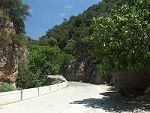Crete: Weather in general
The weather on Crete is typically Mediterranean. In summer, the weather is warm and almost without precipitation. In the south on the coast of the Libyan Sea, it is almost hot. The winter is mild with snow in the mountain regions and rainfall in the lowlands, but still providing enough sunny days.
Due to high temperatures, enough rainfall and high humidity, Crete is one of the greenest islands in the Mediterranean Sea.
Since Crete has a mountainous landscape, the weather can change unexpectedly. In all cases, the weather in summer is almost always sunny, it doesn’t rain, and both the air and sea temperatures are high enough to enjoy your holiday.
Every visitor is different and Crete is very diverse just as its weather, and so it is impossible to say when it is the best time to go. Crete has something for all.
For the weather forecast for the following days, see Weather forecast
Differences in weather by region
East
The eastern part of Crete (the region surrounding the town of Sitia) is rather dry, with low precipitation. The landscape is parched and some areas have scarce vegetation or they seem like a desert (like Karoumbes, for example). The temperature is generally higher than in the central and western part. Many brooks and rivulet beds are dry and they are used as paths to the hidden beauties of the coast (e. g. Hohlakies Gorge or the Gorge of the Dead close to Kato Zakros).
West
The region around the town of Chania and west Crete are characterized by more precipitation and higher humidity. This part of the island is much greener than the eastern part. In the west of the island, the average temperatures are a bit lower than in the east, with the trees and bushes being extremely widespread, and some of the brooks and rivers (like the river Preveli, for example) have water running in them all year long.
South coast
The south coast usually slopes down to the sea abruptly. The air temperatures are higher than in the north, yet because of the sea depth, the water is usually one or two degrees colder than in the north. Both the beaches and water entries are quite steep.
North coast
On the north coast the air temperatures are a bit lower than in the south. The coast descends little by little, so it can warm a bit more. Some prefer to bathe there since the beaches are flatter and water entries longer.
Mountains
In general, the weather in the mountains is colder than in the lowlands or on the coast. In summer the temperatures vary from 15 to 20°C, it is dry everywhere - the springs and rivulets have no water, the mountain regions are often completely parched and at higher altitudes, there is no vegetation.
The winter in the mountains is hard, with frequent snowfall, and in the mountainous parts of the Lefka Ori (White mountains), Psiloritis or Ida mountain ranges, the snow often lasts till May or June.
Temperatures, rainfall and sunshine - longterm averages




